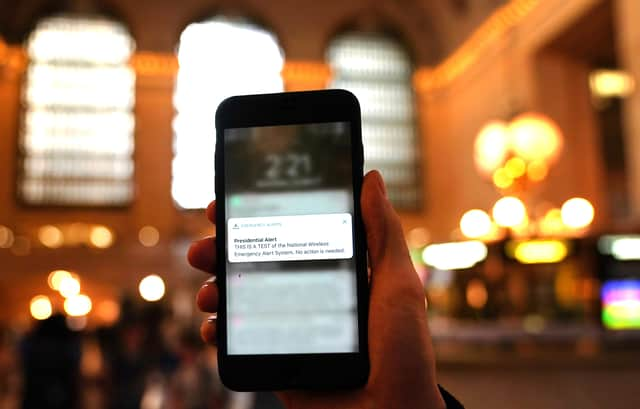U.S. Emergency Alert test: what time message will be sent to cellphones, TV and radio - what to expect?
and live on Freeview channel 276
Millions of Americans will receive an emergency alert message today - but don't worry it is just a test.
FEMA, in coordination with the Federal Communications Commission (FCC), will conduct a nationwide test of the Emergency Alert System (EAS) and Wireless Emergency Alerts (WEA) on Wednesday, 4 October. It follows a similar test held in the UK earlier in 2023.
Advertisement
Hide AdAdvertisement
Hide AdThe purpose of the test is to ensure that the systems continue to be effective means of warning the public about emergencies, particularly those on the national level. In case the test today is postponed due to widespread severe weather or other significant events, the back-up testing date is next Wednesday (11 October).
The WEA portion of the test will be directed to all consumer cell phones. This will be the third nationwide test, but the second test to all cellular devices. The test message will display in either English or in Spanish, depending on the language settings of the wireless handset. The EAS portion of the test will be sent to radios and televisions. This will be the seventh nationwide EAS test.
Here's all you need to know:
When is the emergency alert test?
It will be held on Wednesday, 4 October.
What time will the emergency alert be sent?
The national test will consist of two portions, testing WEA and EAS capabilities. Both tests are scheduled to begin at approximately 2:20 p.m. ET - and it will occur at the same time across time zones.
So you can expect the alert around the following times:
- Hawaii - 8.20am
- Alaska - 10.20am
- Pacific Time - 11.20am
- Central Time - 12.20pm
- Mountain Time - 1.20pm
- Eastern Time - 2.20pm
Which devices will receive the emergency alert?
The test message will be sent to all cellphones, radios and TVs on 4 October.


What to expect from the alert?
Cellphones
Advertisement
Hide AdAdvertisement
Hide AdAll wireless phones should receive the message only once and cell towers will broadcast the test for approximately 30 minutes from 2.20pm E.T. It will read: “THIS IS A TEST of the National Wireless Emergency Alert System. No action is needed.”
Phones with the main menu set to Spanish will display: “ESTA ES UNA PRUEBA del Sistema Nacional de Alerta de Emergencia. No se necesita acción.”
WEA alerts are created and sent by authorized federal, state, local, tribal and territorial government agencies through IPAWS to participating wireless providers, which deliver the alerts to compatible handsets in geo-targeted areas. To help ensure that these alerts are accessible to the entire public, including people with disabilities, the alerts are accompanied by a unique tone and vibration.
Radios and TV
The EAS portion of the test is scheduled to last approximately one minute and will be conducted with the participation of radio and television broadcasters, cable systems, satellite radio and television providers and wireline video providers.
Advertisement
Hide AdAdvertisement
Hide AdThe test message will be similar to the regular monthly EAS test messages with which the public is familiar. It will state: “This is a nationwide test of the Emergency Alert System, issued by the Federal Emergency Management Agency, covering the United States from 14:20 to 14:50 hours ET. This is only a test. No action is required by the public.
Comment Guidelines
National World encourages reader discussion on our stories. User feedback, insights and back-and-forth exchanges add a rich layer of context to reporting. Please review our Community Guidelines before commenting.